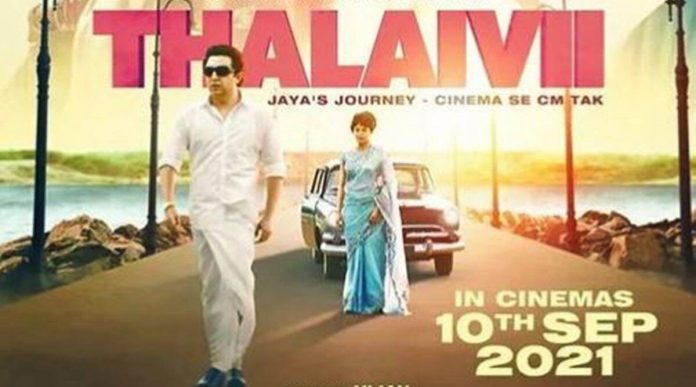Vishnu Vardhan Induri and Shailesh R. Singh’s Thalaivii, which released today (10th September), has been boycotted by the three biggest national multiplex chains of the country. By not releasing the Kangana Ranaut and Arvind Swami starrer, the PVR, Inox and Cinepolis chains have not only spoilt the chances of the film from realising its full box-office potential but have also caused themselves losses.
The three multiplex chains contribute huge revenues to producers because they have a large number of screens spread across the country. Secondly, the admission rates in multiplexes of these three chains are far higher than the rates of single-screen cinemas and many non-national multiplex chains and stand-alone multiplexes too. These two reasons have contributed to a huge loss of revenues for the film in the hands of its producers (Induri and Singh) and distributors (Zee). As for the national multiplex chains, by not releasing the Jayalalithaa biopic in their cinemas, the chains, which are already starved of playing programmes, have further starved themselves of software to run.
Obviously, the producers must have done their math and arrived at the conclusion that it was not worth taking the risk of agreeing to a four-week window for cinemas exclusively because the theatrical shares in the third and fourth weeks would probably be less than the additional amount of money being offered by Netflix…
The argument of the three multiplex chains for ignoring Thalaivii was that the film’s producers did not increase the exclusive theatrical window from two weeks to four weeks, as required by the chains. On the other hand, the film’s producers wanted to premiere it digitally after just two weeks because the price which Netflix was offering them for premiere after a two-week exclusive theatrical window was more than the price for a premiere after a four-week exclusive theatrical window. Obviously, the producers must have done their math and arrived at the conclusion that it was not worth taking the risk of agreeing to a four-week window for cinemas exclusively because the theatrical shares in the third and fourth weeks would probably be less than the additional amount of money being offered by Netflix for a premiere two weeks in advance. The calculation must have been simpler during these COVID times because cinemas in Maharashtra are still shut, and cinemas in most other states are allowed to function at only 50% capacity. There are also restrictions on night shows in many parts of the country. The fear of the third wave of Coronavirus breaking out is still hanging like the Damocles sword over the public’s heads, making many among them reluctant to venture out to the cinemas. All these factors must’ve convinced the producers into believing that the theatrical shares in the third and fourth weeks may not be as alluring as the additional price offered by Netflix for the OTT premiere of Thalaivii after two weeks instead of four. But if that’s the case, why did the producers agree for a four-week exclusive theatrical window in the case of the Tamil and dubbed Telugu versions, you are apt to ask. The reason is that since the story of the film is about the erstwhile Tamil Nadu chief minister, Jayalalithaa, it was bound to hold more appeal for the audience in South India than in the rest of the country. Therefore, the theatrical shares which the two South versions were expected to yield in weeks 3 and 4 would be presumed to be far more than the shares which the Hindi version was expected to yield in the same weeks 3 and 4. It is for this reason that after announcing that all the versions would be premiered digitally after two weeks of theatrical release, the producers increased the theatrical window for the two South versions to four weeks.
The national multiplex chains feared that if they made a concession for THALAIVII, other Bollywood producers would ask for similar concessions.
Interestingly, the same three national multiplex chains — PVR, Inox and Cinepolis — which have ignored the Hindi version, are screening the two South versions. Obviously, they’ve treated each of the three versions as a distinct film. When the producers agreed to change their stance on the Tamil and dubbed Telugu versions and, accordingly, suitably changed their contracts with the OTT rights holder, Amazon Prime, the three multiplex chains clinched deals for those two films. But when all efforts to make the producers similarly change their contract with Netflix for the Hindi version failed, the multiplex chains made it clear that they would not screen the Hindi version. The national multiplex chains feared that if they made a concession for Thalaivii, other Bollywood producers would ask for similar concessions. Their agreeing to screen Thalaivii in their cinemas would jeopardise the agreements they (multiplex chains) had signed with Bollywood producers like Yash Raj Films for an exclusive four-week theatrical window. That was a scary prospect for the multiplexes which were trying their best to revive business after a horrifying 17 months during the first and second waves of the Coronavirus.
The producers tried to reason out that they were insisting on a two-week window mainly because cinemas in Maharashtra were yet shut, and that other producers like YRF may not have to release their films before cinemas in Maharashtra reopen, so the multiplex chains needn’t be fearful of their contracts with Bollywood producers being jeopardised if the chains made an exception for Thalaivii. But this logic failed to cut ice with the multiplex chains.
Since multiplexes have had
to bear a huge brunt of the losses during the lockdowns, they need to be able to quickly stand on their feet again if they are to avoid permanent closure.
There is no right or wrong in the present case. When one hears the logic of the producers of Thalaivii, one is constrained to feel that they are right in insisting on a two-week exclusive theatrical window. But when one hears the multiplex chains’ version, one feels that they are justified in insisting on a four-week exclusive window because if they don’t do so, their business might take several years to come on track. Since multiplexes have had to bear a huge brunt of the losses during the lockdowns, they need to be able to quickly stand on their feet again if they are to avoid permanent closure. And they can do so if they put their foot down on certain things like insisting on a four-week exclusive cinema window during these trying and testing times.
…the national chains should’ve agreed to screen THALAIVII. For, having reopened a lot of properties, the chains need a constant flow of software to keep running.
Those who feel, multiplexes and single-screen cinemas are already on oxygen and, therefore, should not be so picky and choosy, are convinced that even if for only two weeks of exclusivity, the national chains should’ve agreed to screen Thalaivii. For, having reopened a lot of properties, the chains need a constant flow of software to keep running. On the other hand, those favouring the multiplex chains opine that if these chains were to agree to a two-week window, they would be indulging in a self-defeating exercise. Frankly, in a lot of income-tax cases, even the courts have often held that nobody, not even the income-tax department, can teach a businessman how to do his business. If the producer has a right to look after his own interest, the multiplex chains, too, should be granted that right. If they feel, they are better off by boycotting a film, so be it.
Surprisingly, these very multiplex chains, which relied so heavily on emulating the Hollywood model in pre-COVID times, are now pretending that they don’t know what the scene in Hollywood is.
However, it must be added here that before COVID-19 struck, every time the point of sharing box-office revenues was discussed between the national multiplex chains on the one hand and producers/distributors on the other, the former gave the Hollywood example and convinced the latter to increase the share of multiplexes in the net box-office collections for each passing week. Surprisingly, these very multiplex chains, which relied so heavily on emulating the Hollywood model in pre-COVID times, are now pretending that they don’t know what the scene in Hollywood is. For their information, post-COVID, all the leading exhibition chains in the US are screening films which are being streamed simultaneously on OTT platforms. Surely, a two-week exclusive cinema window is better (for the multiplex chains) than a day-and-date release in cinemas and on OTT.




























